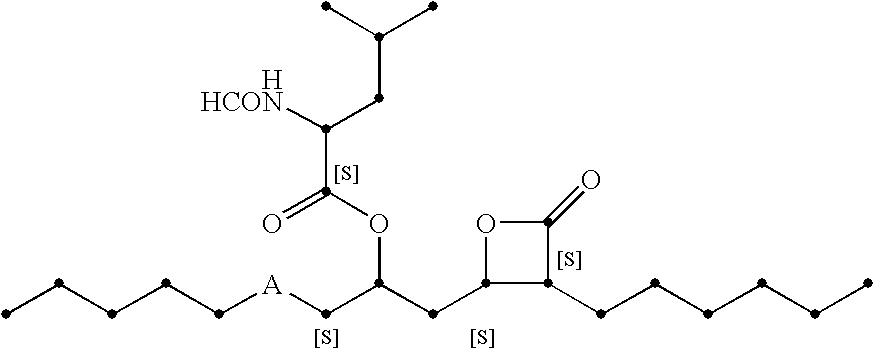Use of non-digestible polymeric foams to sequester ingested materials thereby inhibiting their absorption by the body
- Summary
- Abstract
- Description
- Claims
- Application Information
AI Technical Summary
Benefits of technology
Problems solved by technology
Method used
Image
Examples
example 1
[0124] HIPE foams which are useful in accordance with the present invention may be prepared by the following non-limiting processes:
Sheet Form Process:
[0125] General methods for preparing HIPE foams are described in U.S. Pat. No. 5,149,720 DesMarais et al., issued Sep. 22, 1992, U.S. Pat. No. 5,260,345, DesMarais et al., issued Nov. 9, 1993; U.S. Pat. No. 5,268,224, DesMarais et al., issued Dec. 7, 1993; U.S. Pat. No. 5,563,179, Stone et al., issued Oct. 8, 1996; U.S. Pat. No. 5,650,222, DesMarais et al., issued Jul. 22, 1997; U.S. Pat. No. 5,741,518, DesMarais et al., issued Apr. 21, 1998; and U.S. Pat. No. 5,827,909, DesMarais et al., issued Oct. 27, 1998.
[0126] A HIPE foam is prepared according to the method described in U.S. Pat. No. 5,650,222, DesMarais et al., issued Jul. 22, 1997, using a water phase comprising 10% calcium chloride and 0.05% potassium persulfate and an oil phase comprising 55 parts EHA, 33 parts DVB-42, 12 parts HDDA, and 6 parts DGMO. The water:oil ratio...
example 2
[0142] Two groups of rats were matched by weight and placed on a high-fat (17% lard, by weight) diet for 9 days. One of the groups also received the ground particulate HIPE foam from Example 1, Sample 3 at 1.0% of the diet. The diet of the other (Control) group contained 17% lard without any HIPE foam. Total intake and fecal output were measured each day. Pooled feces from the last five days of the feeding period are analyzed for fat content according to AOAC method 954.04, published by AOAC International, Gaithersburg, Md. The results are indicated in the table below.
% HIPE Foam in DietExcreted Fat (as % Ingested Fat)Std. Error0% (No foam)5.730.281.0% foam10.990.74
Normal fat excretion was roughly doubled in the group which was fed HIPE foam. No adverse effects of HIPE foam on the animals were apparent. All rats continued to eat throughout the experiment and maintain normal drinking and grooming. This observation tends to rule out the presence of any illness due to use of the mat...
example 3
[0143] Four groups of rats were matched by weight and placed on a high-fat (17% lard, by weight) diet for 4 weeks. Three of the groups also received ground particulate HIPE foam from Example 1, Sample 3 at 0.25%, 0.5% or 1.0% of the diet. The diet of the fourth (Control) group did not contain HIPE foam. Total intake and fecal output were measured each day during the fourth treatment week. Pooled feces were analyzed for fat content according to AOAC method 954.04, published by AOAC International, Gaithersburg, Md. All three groups receiving HIPE foam showed statistically significant increases in fat excretion relative to the control group during the fourth week of treatment. The results are presented in the table below:
% HIPE Foam in DietExcreted Fat (as % Ingested Fat)Std. Error0% (Control)8.770.420.25%14.210.710.5%17.240.521.0%16.090.74
[0144] Normal fat excretion increased by about 50 to about 96% in the groups which received HIPE foam as the dose was increased from 0.25% to 1.0%...
PUM
 Login to View More
Login to View More Abstract
Description
Claims
Application Information
 Login to View More
Login to View More - R&D
- Intellectual Property
- Life Sciences
- Materials
- Tech Scout
- Unparalleled Data Quality
- Higher Quality Content
- 60% Fewer Hallucinations
Browse by: Latest US Patents, China's latest patents, Technical Efficacy Thesaurus, Application Domain, Technology Topic, Popular Technical Reports.
© 2025 PatSnap. All rights reserved.Legal|Privacy policy|Modern Slavery Act Transparency Statement|Sitemap|About US| Contact US: help@patsnap.com



